MediaTek LinkIt Smart 7688 - platform for IoT and automation systems
The development of the IoT and home automation segments today is hampered, in particular, by the lack of affordable actuators and sensors. For the DIY market, this in a sense is offset by the presence of a variety of platforms based on microcontrollers and microprocessors, which are relatively inexpensive. So if you are not ready to use the “boxed” solution and like to develop your own projects, you can easily choose the suitable option.
A couple of years ago MediaTek launched the LinkIt ONE platform for developing prototypes of devices for the wearable electronics and IoT segments, which, thanks to a unique combination of hardware capabilities and effective software support, has become quite popular among enthusiasts.
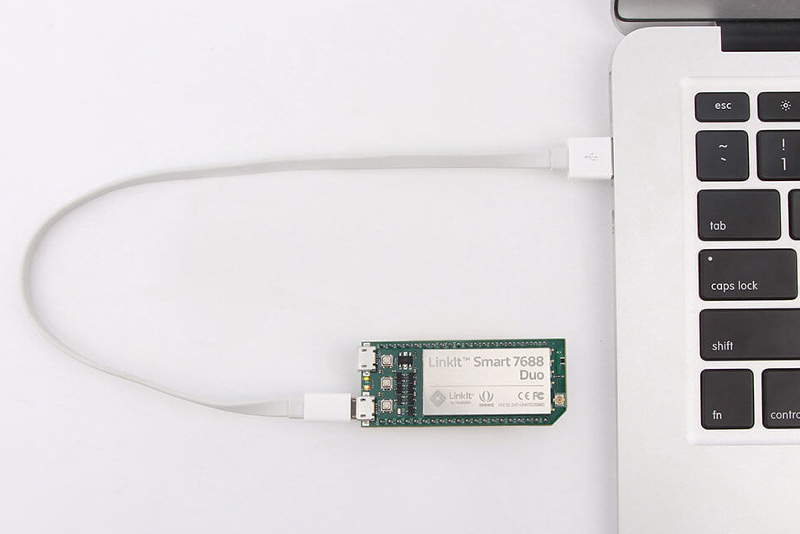
At the end of last year, the company released two new models - LinkIt Smart 7688 and LinkIt Smart 7688 Duo, which are significantly faster, cheaper and more compact, but have fewer built-in controllers. Like its predecessor, they were developed in conjunction with Seeed .
Today in these market segments there are no fixed configuration options, so you can choose other models for comparison only approximately. In our opinion, a step below you can put devices based on the ESP8266 chip, next to it is Arduino Yún, and above it is Intel Edison. Solutions such as the Raspberry Pi and BeagleBone are still significantly more powerful and, in addition, do not have built-in Wi-Fi. Also, from a certain point of view, you can compare these platforms with OpenWRT-compatible routers.
Already by the specifications it is clear that we have a unique product that may be optimal for a certain class of IoT solutions and automation systems. It has a fairly powerful computing platform, built-in Wi-Fi, USB and GPIO, as well as software support for C / C ++, Python, Node.js and Arduino IDE.
The basis of the LinkIt Smart 7688 board is the SoC MT7688AN, which has a computing core, MIPS24KEc, which operates at a frequency of 580 MHz. The amount of RAM is an impressive 128 MB, a flash memory of 32 MB is provided for the firmware. In addition, the board has a slot for microSDHC memory cards and a microUSB (OTG) port.
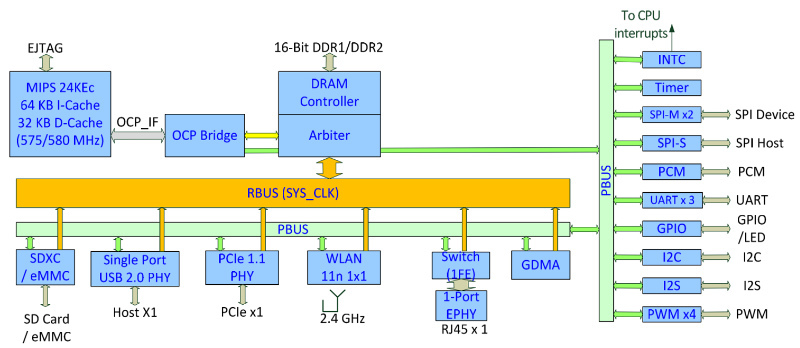
The device is equipped with a wireless controller standard 802.11b / g / n, operating at a frequency of 2.4 GHz with a maximum connection speed of 150 Mbps. There is a built-in antenna on the board, if necessary, you can connect an external one. In addition, the model also has a 10/100 Mbps wired network controller.
The chip has 22 GPIO pins with interrupt support, some of which can perform several functions depending on the configuration. In particular, there are four outputs with PWM, SPI master and SPI slave, I2S, I2C, three UART, a USB 2.0 host. Note that there are no analog inputs and outputs in this product. There is no video output either. As for the sound, you can use the codec for the I2S bus or a USB adapter.
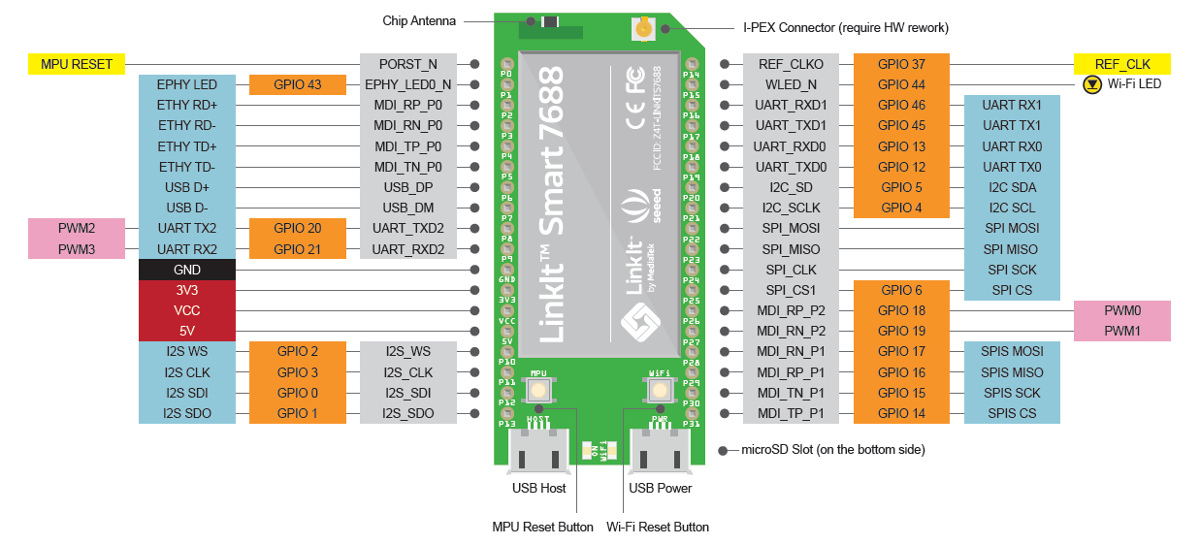
The board can be powered from 5 V via a USB port and built-in stabilizer, or directly from 3.3 V, which are standard for this platform. Consumption information can be found in the developer documentation. There are numbers from 200 to 600 mA, depending on the scenario. So a standard 5 V 1 A power supply will be more than enough, but realizing a long battery life will not be easy.
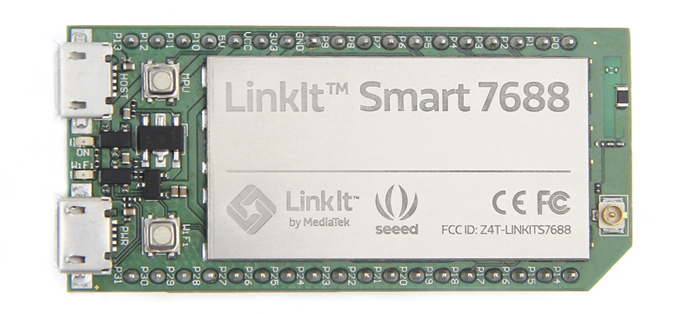
The circuit board has dimensions of about 56 x26 mm. On the front side under the screen is the main processor and RAM chip. We also see here USB connectors (one for power, one for external devices), a pair of LEDs, two buttons, a power regulator chip. On the reverse side of the board there are two combs of 18 contacts for installation on a breadboard, a slot for memory cards and a flash memory chip.
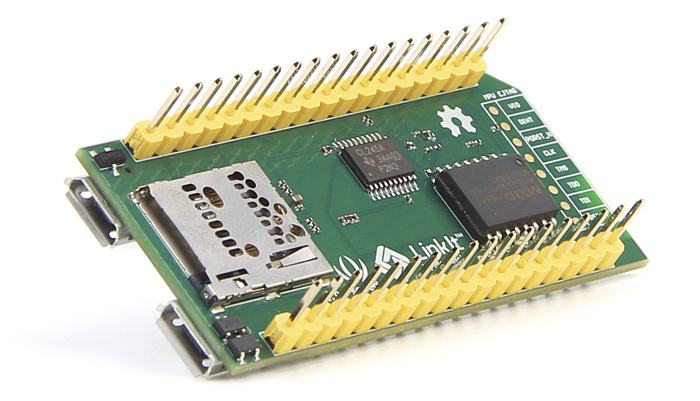
The firmware is based on the popular OpenWRT Linux distribution. Several useful packages are included, including the Python and Node.js languages (including libraries for accessing serial ports and GPIO from them), OpenSSL, an ssh server, UVC-camera modules with a USB interface, and others.
The company provides an SDK for Linux and OS X that allows you to create software for C / C ++ devices. For this scenario, there is also a native library for servicing I / O ports.
The MediaTek Cloud Sandbox cloud service will help bring your devices to the Internet , allowing you to implement remote management, event and action processing, data storage and other functions.
Despite the fact that the LinkIt Smart 7688 version has wide capabilities for connecting external devices, it is relatively difficult to program, especially if you have previously dealt only with Arduino-like devices. For these users, the company offers a modification of LinkIt Smart 7688 Duo, which is very similar in logic to working on Arduino Yún. The main SoC MT7688AN in it is responsible for maintaining the network, USB and OpenWRT, and the inputs and outputs work in conjunction with the optionally installed MCU ATmega32U4 chip (8 MHz, 3.3 V). This chip can be seen on the back of the board.
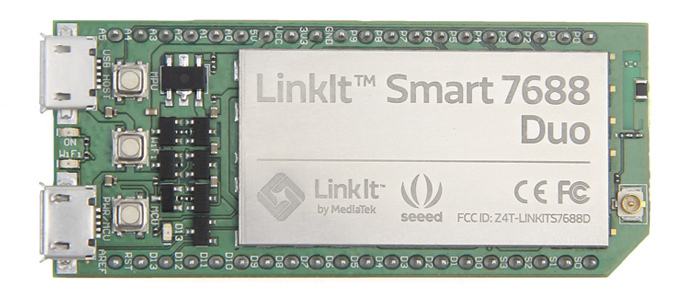
The length of the device has increased to 61 mm due to the need to add several conclusions. On the front side we see an additional MCU reset button, and the USB power port is now also used to connect the MCU when working with the Arduino IDE.
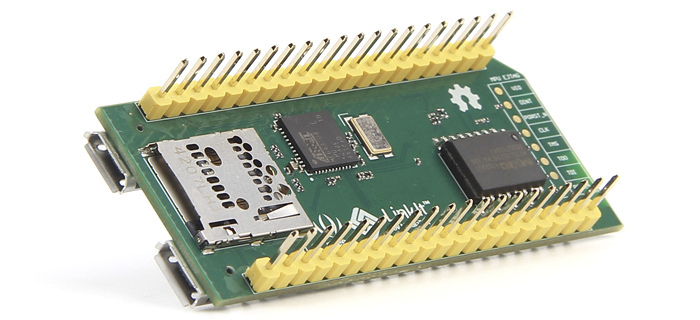
This modification has the same amount of RAM and flash memory, support for USB host, Wi-Fi, memory cards and a wired network interface. Only three GPIOs are derived from the MediaTek chip, two of which provide a serial interface to the OpenWRT console. All other contacts, a total of 24 pieces, are in charge of ATmega. In particular, there are 8 outputs with PWM, 12 inputs ADC, 8 inputs with interrupt support, SPI, I2C and UART.
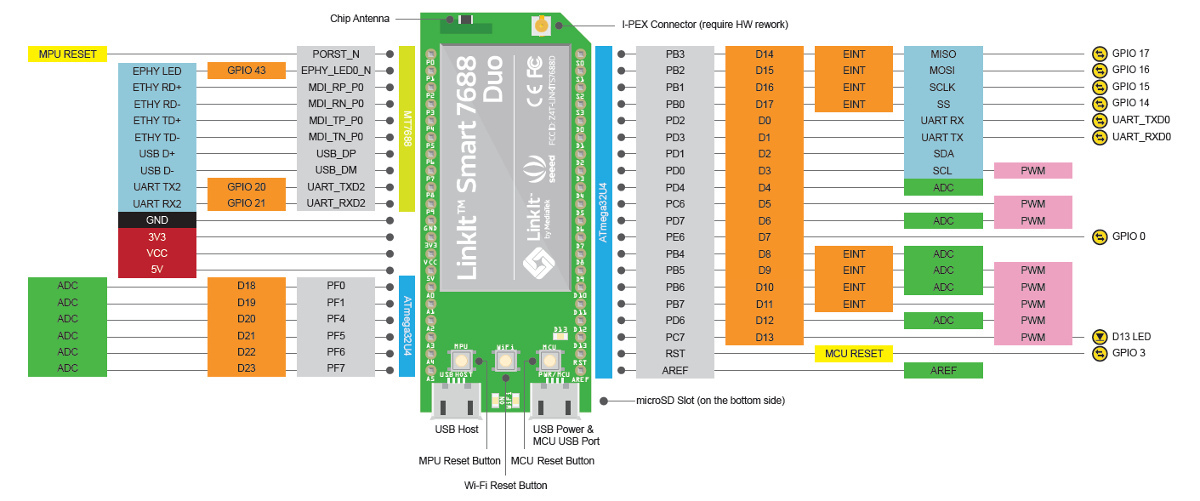
Three options are provided for the interconnection of MPU and MCU - data exchange between controllers via UART, as well as support for Firmata and Bridge libraries.
The platform is relatively new, but publications on its basis can already be found on the network. Thanks to the controller’s rich capabilities, the range of tasks to be solved is very wide - from a stand-alone smoke detector with information via Twitter, to voice-controlled equipment and HVAC tasks .

On the Seeed Studio website , the LinkIt Smart 7688 module is offered for $ 12.90, while for the LinkIt Smart 7688 Duo they are asking for $ 15.90. Given the capabilities of the platforms, prices do not seem high. However, here it will already be necessary to look according to your requirements. It is possible that the problem can be solved with a more affordable controller. But for DIY solutions are clearly of great interest.
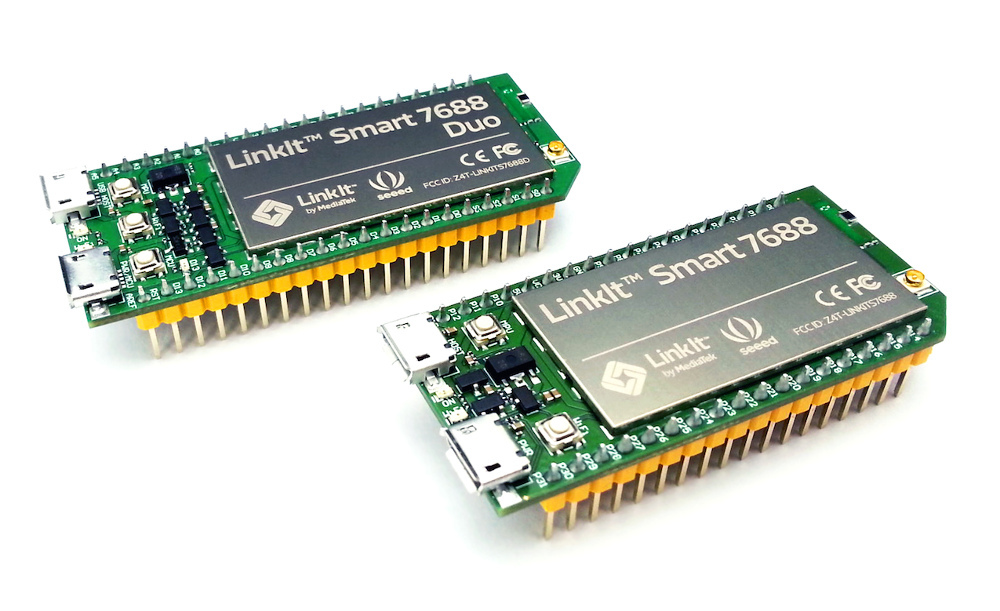
Additionally, you can purchase Breakout for LinkIt Smart 7688 ($ 15.95), which has a network port, sound controller, as well as a standard USB port for peripherals. There is also an Arduino Breakout for LinkIt Smart 7688 Duo ($ 12.95) in the store’s assortment, also with a network, USB and a large number of standard Grove connectors for sensors and actuators.
All device information, including software, documentation, and examples can be found in the appropriate section of the MediaTek Labs community . It is interesting to note that as of last year, almost a fifth of it is made up of representatives of Russia and countries of Eastern Europe.
A couple of years ago MediaTek launched the LinkIt ONE platform for developing prototypes of devices for the wearable electronics and IoT segments, which, thanks to a unique combination of hardware capabilities and effective software support, has become quite popular among enthusiasts.

At the end of last year, the company released two new models - LinkIt Smart 7688 and LinkIt Smart 7688 Duo, which are significantly faster, cheaper and more compact, but have fewer built-in controllers. Like its predecessor, they were developed in conjunction with Seeed .
Today in these market segments there are no fixed configuration options, so you can choose other models for comparison only approximately. In our opinion, a step below you can put devices based on the ESP8266 chip, next to it is Arduino Yún, and above it is Intel Edison. Solutions such as the Raspberry Pi and BeagleBone are still significantly more powerful and, in addition, do not have built-in Wi-Fi. Also, from a certain point of view, you can compare these platforms with OpenWRT-compatible routers.
Already by the specifications it is clear that we have a unique product that may be optimal for a certain class of IoT solutions and automation systems. It has a fairly powerful computing platform, built-in Wi-Fi, USB and GPIO, as well as software support for C / C ++, Python, Node.js and Arduino IDE.
LinkIt Smart 7688 Hardware Features
The basis of the LinkIt Smart 7688 board is the SoC MT7688AN, which has a computing core, MIPS24KEc, which operates at a frequency of 580 MHz. The amount of RAM is an impressive 128 MB, a flash memory of 32 MB is provided for the firmware. In addition, the board has a slot for microSDHC memory cards and a microUSB (OTG) port.

The device is equipped with a wireless controller standard 802.11b / g / n, operating at a frequency of 2.4 GHz with a maximum connection speed of 150 Mbps. There is a built-in antenna on the board, if necessary, you can connect an external one. In addition, the model also has a 10/100 Mbps wired network controller.
The chip has 22 GPIO pins with interrupt support, some of which can perform several functions depending on the configuration. In particular, there are four outputs with PWM, SPI master and SPI slave, I2S, I2C, three UART, a USB 2.0 host. Note that there are no analog inputs and outputs in this product. There is no video output either. As for the sound, you can use the codec for the I2S bus or a USB adapter.

The board can be powered from 5 V via a USB port and built-in stabilizer, or directly from 3.3 V, which are standard for this platform. Consumption information can be found in the developer documentation. There are numbers from 200 to 600 mA, depending on the scenario. So a standard 5 V 1 A power supply will be more than enough, but realizing a long battery life will not be easy.

The circuit board has dimensions of about 56 x26 mm. On the front side under the screen is the main processor and RAM chip. We also see here USB connectors (one for power, one for external devices), a pair of LEDs, two buttons, a power regulator chip. On the reverse side of the board there are two combs of 18 contacts for installation on a breadboard, a slot for memory cards and a flash memory chip.

Software support
The firmware is based on the popular OpenWRT Linux distribution. Several useful packages are included, including the Python and Node.js languages (including libraries for accessing serial ports and GPIO from them), OpenSSL, an ssh server, UVC-camera modules with a USB interface, and others.
The company provides an SDK for Linux and OS X that allows you to create software for C / C ++ devices. For this scenario, there is also a native library for servicing I / O ports.
The MediaTek Cloud Sandbox cloud service will help bring your devices to the Internet , allowing you to implement remote management, event and action processing, data storage and other functions.
Modification LinkIt Smart 7688 Duo
Despite the fact that the LinkIt Smart 7688 version has wide capabilities for connecting external devices, it is relatively difficult to program, especially if you have previously dealt only with Arduino-like devices. For these users, the company offers a modification of LinkIt Smart 7688 Duo, which is very similar in logic to working on Arduino Yún. The main SoC MT7688AN in it is responsible for maintaining the network, USB and OpenWRT, and the inputs and outputs work in conjunction with the optionally installed MCU ATmega32U4 chip (8 MHz, 3.3 V). This chip can be seen on the back of the board.

The length of the device has increased to 61 mm due to the need to add several conclusions. On the front side we see an additional MCU reset button, and the USB power port is now also used to connect the MCU when working with the Arduino IDE.

This modification has the same amount of RAM and flash memory, support for USB host, Wi-Fi, memory cards and a wired network interface. Only three GPIOs are derived from the MediaTek chip, two of which provide a serial interface to the OpenWRT console. All other contacts, a total of 24 pieces, are in charge of ATmega. In particular, there are 8 outputs with PWM, 12 inputs ADC, 8 inputs with interrupt support, SPI, I2C and UART.

Three options are provided for the interconnection of MPU and MCU - data exchange between controllers via UART, as well as support for Firmata and Bridge libraries.
Conclusion
The platform is relatively new, but publications on its basis can already be found on the network. Thanks to the controller’s rich capabilities, the range of tasks to be solved is very wide - from a stand-alone smoke detector with information via Twitter, to voice-controlled equipment and HVAC tasks .
On the Seeed Studio website , the LinkIt Smart 7688 module is offered for $ 12.90, while for the LinkIt Smart 7688 Duo they are asking for $ 15.90. Given the capabilities of the platforms, prices do not seem high. However, here it will already be necessary to look according to your requirements. It is possible that the problem can be solved with a more affordable controller. But for DIY solutions are clearly of great interest.

Additionally, you can purchase Breakout for LinkIt Smart 7688 ($ 15.95), which has a network port, sound controller, as well as a standard USB port for peripherals. There is also an Arduino Breakout for LinkIt Smart 7688 Duo ($ 12.95) in the store’s assortment, also with a network, USB and a large number of standard Grove connectors for sensors and actuators.
All device information, including software, documentation, and examples can be found in the appropriate section of the MediaTek Labs community . It is interesting to note that as of last year, almost a fifth of it is made up of representatives of Russia and countries of Eastern Europe.
